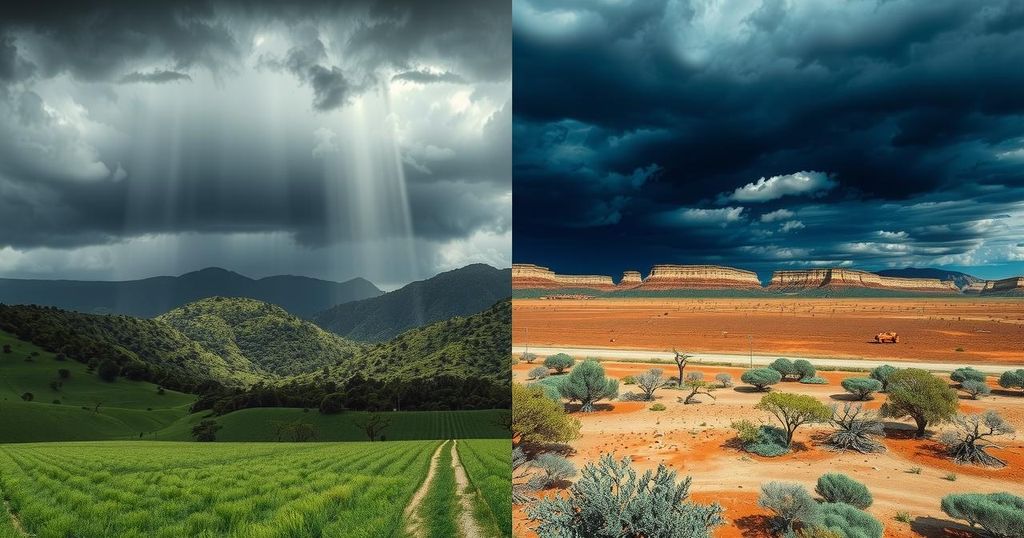Unsettled Weather Across Australia: Monsoon Arrives in the North Amid Southern Heat

Australia is experiencing wild weather as the monsoon season begins in the north, bringing heavy rain and flooding to Queensland while parts of the south endure extreme heat and bushfire threats. A tropical cyclone may develop off the coast of Western Australia, with severe weather warnings issued across various regions. Authorities emphasize preparedness amid these significant climatic events.
Australia is currently experiencing a tumultuous week of weather, with the monsoon season finally commencing in the north, bringing much-needed rain to some areas while creating challenges in others. The Bureau of Meteorology has announced that this year’s monsoon started later than usual, marking the latest onset in Darwin since 1957. Tropical systems are developing, with the potential for the first tropical cyclone of the season, while southern regions contend with extreme heat and heightened bushfire risks.
In northern Australia, the arrival of the monsoon corresponds with a shift in wind patterns that allows warm, humid air to flow in from Indonesia. This has resulted in significant rainfall across Queensland, where an ongoing flooding crisis has seen rainfall totals reach up to two meters. The Bureau of Meteorology (BOM) predicts additional heavy rains in the upcoming days, particularly threatening already saturated river catchments and leading to potential flooding.
Authorities have issued severe weather warnings for numerous areas in Queensland, including from Ayr to Tully and extending to the Gulf Coast. Tragically, the recent flooding has led to two fatalities and left approximately 1,900 homes without power amidst a broader impact on over 33,000 properties from the weather event. Flood warnings remain for specific river systems as water levels are closely monitored.
Meanwhile, a tropical low forming off Western Australia’s coast could develop into the first tropical cyclone of the year, potentially named Zelia. This system may cross the coast later this week, bringing heavy rainfall and strong winds. Residents are advised to remain vigilant and prepared as conditions become favorable for tropical cyclone development, with flood watches issued for areas in the Kimberley.
Conversely, southern Australia is grappling with extreme heat, with temperatures soaring above 47 degrees Celsius in Western Australia and moving eastward. Forecasts predict heatwave conditions will affect South Australia, Victoria, and Tasmania in the coming days. While the intensity may not surpass previous heatwaves, measures are urgently needed to address the increased risk of bushfires, particularly in regions recovering from recent fires in Victoria.
This week’s forecasts anticipate thunderstorms and severe weather across New South Wales and eastern Victoria, bringing flash flooding and damaging hail. Ongoing advisories call for residents to stay alert to weather warnings and emergency guidance as the country navigates this swift and severe weather transition. Managing these competing weather challenges will require coordination and vigilance across the regions.
The weather conditions in Australia vary dramatically from north to south, affected by seasonal changes such as the monsoon, which brings moisture to the northern regions while southern states are experiencing severe heat and bushfire risks. The Bureau of Meteorology plays a crucial role in monitoring these events, providing warnings, and guiding residents through the challenges posed by adverse weather conditions. The extremes in weather highlight the country’s vulnerability to climatic shifts, especially during the summer months when both severe rainfall and extreme heat occur simultaneously.
In conclusion, Australia is facing a complex weather situation characterized by the late arrival of the monsoon in the north, leading to significant rainfall and flooding, while the south suffers from intense heat and bushfire threats. With predictions of cyclone activity and ongoing severe weather warnings, authorities emphasize the importance of preparedness and vigilance for residents across affected regions. The need for adaptive measures in response to such extreme weather variations is more pressing than ever.
Original Source: www.abc.net.au







